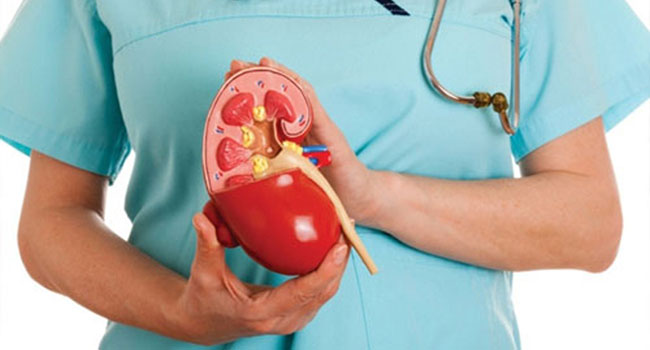Symptoms and treatment of kidney necrosis
Necrosis of the kidney is diagnosed with destructive processes in the tissues of the organ, which are manifested by swelling of protein molecules. Kidney destruction develops as a pathological complication of many diseases or as a result of intoxication of the body. This disease is dangerous because it can initiate kidney failure.
The kidney is a paired bean-shaped organ whose main task is to form urine and protect blood from intoxication by filtering it.
Additional functions of the kidneys are:
- excretion of toxins and drugs in the urine;
- regulation of electrolytes in the bloodstream;
- control of acid-base balance;
- support healthy blood pressure levels;
- production of biologically active substances.
The right kidney is smaller than the left, and it is more prone to various pathologies. The adrenal glands are located in the upper region of the body, their task is hormonal synthesis. The hormones produced control the metabolic processes in the body, affect the functioning of the circulatory system, internal organs, and the skeleton.
Violation of renal functioning affects the general well-being of a person. One of the dangerous pathologies is necrosis. Atherosclerosis, thrombosis, diabetes mellitus, and analgesics contribute to the onset of the disease.
Characteristics of the pathology
With necrosis of the kidneys, damage to the cytoplasmic proteins is fixed, in which the cellular structure of the organ dies. The disease is diagnosed in people of different ages, including newborns.
The main causes of the disease include:
- infectious processes, sepsis;
- trauma, blood loss;
- placental passage during pregnancy;
- kidney rejection after transplantation;
- intoxication with chemical compounds;
- exacerbation of cardiovascular pathologies.
Depending on the localization of the lesion, there are cortical, tubular, papillary types of the disease.

Cortical
A rarely diagnosed type of necrosis, in which the outer renal membrane is affected, while the inner remains intact. The cause of the pathology is the blockage of small vessels that feed the cortical layer.
Kidney disease is manifested by the following symptoms:
- reduction or absence of urination;
- blood in the urine;
- heat.
In addition, changes in blood pressure values, as well as pulmonary edema, are possible.
Important! Endotoxic shock contributes to the centralization of blood flow, its deficiency, which causes necrosis of the tissues of the organ.
The cortical appearance is often found in infants. This is due to placental abruption, blood poisoning, infectious processes. In women, in most cases, the disease manifests itself in the postpartum period due to uterine bleeding, infectious diseases, and compression of the arteries.
Papillary
Papillary necrosis is the death of the renal papilla. The functionality of the organ is impaired due to the destruction of the brain area.
By the way! In patients suffering from pyelonephritis, papillary necrosis is diagnosed in 3% of cases.
The acute form of the disease is manifested by colic, chills, cessation of urination.
The causes of pathology are:
- dysfunction of the blood supply to the brain and renal papillae;
- violation of the outflow of urine in the pelvis;
- inflammatory phenomena, purulent formations in the organ;
- toxic poisoning of the tissue structure of the kidney.
The disease is more common in women.
tubular
Tubular necrosis of the kidneys (acute tubular) is characterized by damage to the mucous membrane of the tubules of nephrons, which provokes renal failure.
Acute tubular necrosis occurs in two forms:
- Ischemic. Pathology is caused by mechanical damage, sepsis, "oxygen starvation" of the blood, inflammation.
- Nephrotoxic. It becomes a consequence of severe intoxication of the body.
Acute tubular necrosis develops as a result of severe damage to the epithelium of the tubules, accompanied by intense tissue inflammation. As a result, the renal structure changes, initiating organ failure.

Methods of diagnosis and treatment
The collection of anamnesis plays a predominant role in the diagnosis. Samples are taken, ultrasound scans and X-rays are taken. A CT scan may be needed. Each type of disease is differentiated in different ways.
The main therapeutic task is to eliminate inflammatory foci and prevent the death of the renal structure and tubules. The treatment regimen for necrosis depends on the type of disease and the factors that provoked the disease.
Therapeutic measures:
- When a papillary species is detected, antispasmodics are prescribed. In case of obstruction of the ureter, a catheter must be inserted. Medicines are used that restore blood supply, increase the immune status, and antibiotics. In the absence of positive dynamics from drug therapy, it is necessary to remove the affected organ.
- Acute tubular necrosis is treated with antibacterial drugs that regulate blood circulation in the kidney. The body is cleansed of toxic elements.
- With a cortical form of pathology, treatment is aimed at restoring blood flow in the brain section of the organ. Infections are eliminated with antibiotics.
With untimely therapy, renal failure develops, which is accompanied by intense poisoning of the body with damage to other organs.
The operation is prescribed only in advanced cases, when the destruction affects the entire structure of the kidney. In case of thrombosis of the vessel, thrombectomy is performed.
In the case of diagnosing the disease at the initial stage, the work of the kidney can be restored. However, many patients are shown a regular procedure of dialysis (blood cleansing) or organ transplantation. Recovery is based on the elimination of a bacterial infection and on improving the reactivity of the human body.
Renal necrosis is a serious disease leading to death if left untreated. To prevent irreparable consequences, undergo regular examinations. If you experience strange symptoms, contact your doctor immediately.




